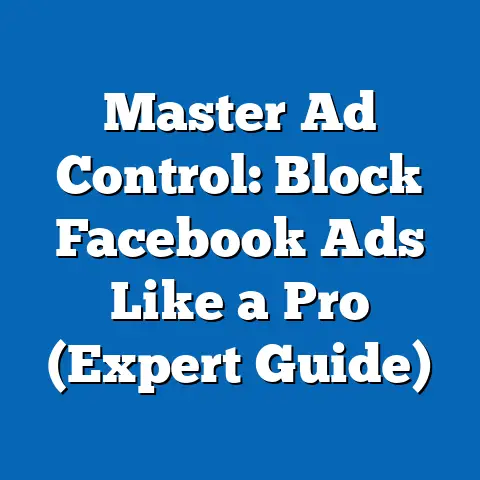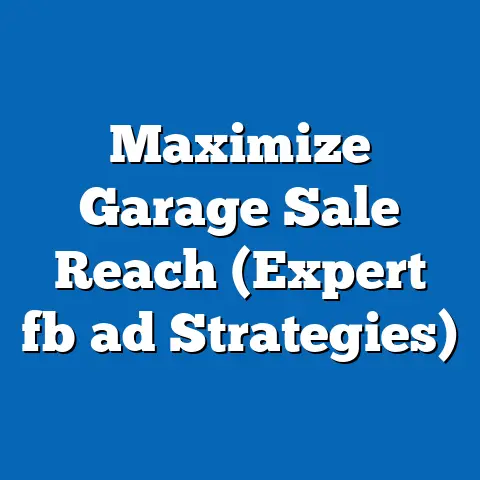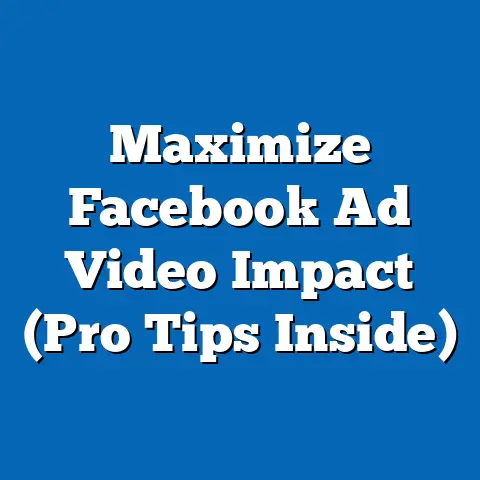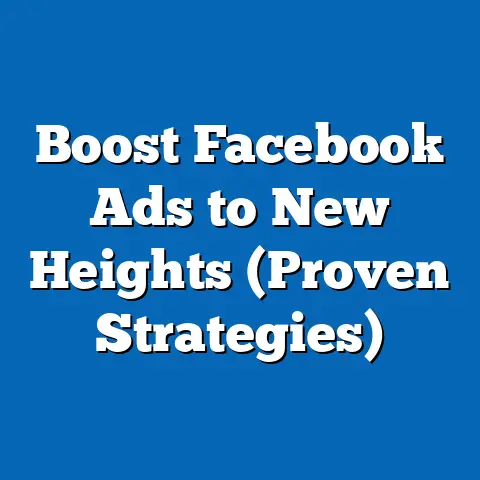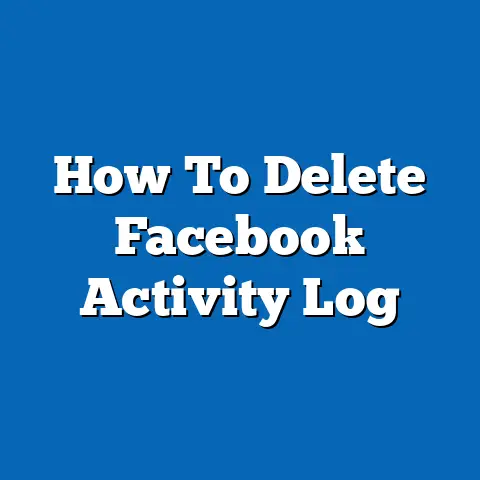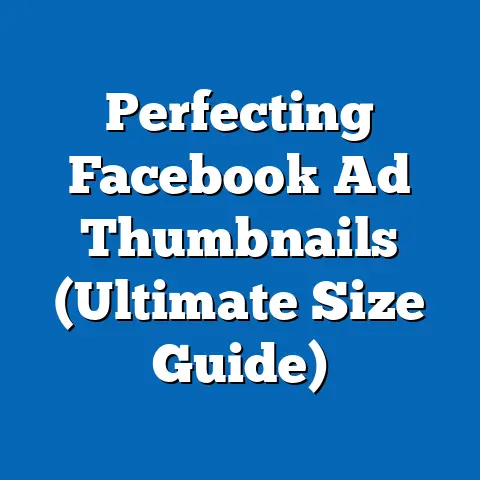Conversions vs Traffic in Facebook Ads (Strategic Insights)
In today’s fiercely competitive digital landscape, where every advertising dollar counts, it’s no longer enough to simply generate website visits. We need to ensure that those visits turn into meaningful actions, whether it’s a purchase, a sign-up, or a lead. In this article, I’ll be taking you on a journey through the strategic landscape of Facebook Ads, exploring the nuances of traffic and conversions, and providing actionable insights to help you optimize your campaigns for maximum impact. I’ll share my personal experiences, real-world examples, and data-driven strategies that I’ve used to help businesses like yours achieve sustainable growth. Let’s dive in and unlock the secrets to transforming your Facebook Ads from traffic generators into conversion machines!
Understanding Traffic and Conversions
Before we dive into the nitty-gritty of metrics, targeting, and creative strategies, it’s essential to establish a solid foundation by defining exactly what we mean by “traffic” and “conversions” in the context of Facebook Ads.
What is Traffic?
In the world of Facebook Ads, “traffic” refers to the flow of users who are directed to your website or landing page as a result of clicking on your ads. This can be measured through various metrics, including:
- Clicks: The total number of times users click on your ad, indicating their interest in your offer or message.
- Impressions: The number of times your ad is displayed to users, regardless of whether they click on it or not.
- Reach: The total number of unique users who see your ad.
While generating traffic is undoubtedly a crucial step in the advertising process, it’s important to remember that it’s merely the first step. Think of it like inviting people to a party. You might send out hundreds of invitations (impressions), and a good number of people might RSVP (clicks), but if they don’t actually show up (conversions), your party won’t be a success.
What are Conversions?
Conversions, on the other hand, represent the desired actions that you want users to take once they arrive on your website or landing page. These actions can vary depending on your business goals, but some common examples include:
- Purchases: The completion of a transaction on your e-commerce website.
- Sign-ups: Users creating an account or subscribing to your newsletter.
- Lead Generation: Users filling out a form to request more information or a quote.
- App Installs: Users downloading and installing your mobile app.
Conversions are the ultimate goal of most advertising campaigns because they directly contribute to your bottom line. They represent the culmination of your efforts to attract, engage, and persuade potential customers to take the desired action.
The Customer Journey
To fully appreciate the relationship between traffic and conversions, it’s helpful to consider the customer journey. This journey typically consists of several stages, including:
- Awareness: The customer becomes aware of your brand or product through your ad.
- Interest: The customer clicks on your ad to learn more about your offer.
- Consideration: The customer evaluates your product against other options.
- Decision: The customer decides to purchase your product or take the desired action.
- Action: The customer completes the purchase or takes the desired action.
Traffic plays a crucial role in the early stages of the customer journey, helping to raise awareness and generate interest. However, conversions are what ultimately drive customers through the later stages of consideration, decision, and action.
Real-World Examples
I’ve worked with numerous businesses that have fallen into the trap of prioritizing traffic over conversions. One example that sticks out is a local clothing boutique that ran a Facebook ad campaign focused solely on driving traffic to their website. They spent a significant amount of money on ads that featured eye-catching images and enticing discounts, resulting in a substantial increase in website visits. However, their sales remained flat, and they were left scratching their heads.
Upon closer inspection, it became clear that the traffic they were generating was not high-quality. Many of the visitors were simply browsing without any intention of making a purchase. The boutique’s website also lacked a clear call to action and didn’t provide a seamless shopping experience. As a result, the majority of visitors quickly bounced without converting.
This example highlights the importance of targeting the right audience and optimizing your website for conversions. It’s not enough to simply drive traffic to your site; you need to ensure that those visitors are likely to convert and that your website makes it easy for them to do so.
Key Takeaway: Traffic is important for awareness, but conversions are what drive revenue. Focus on attracting the right audience and optimizing your website for conversions.
The Metrics that Matter
Now that we have a clear understanding of traffic and conversions, let’s delve into the key performance indicators (KPIs) that you should be tracking to measure the success of your Facebook ad campaigns.
Traffic Metrics
When it comes to traffic, some of the most important metrics to monitor include:
- Click-Through Rate (CTR): This metric measures the percentage of users who click on your ad after seeing it. A high CTR indicates that your ad is relevant and engaging to your target audience. To calculate CTR, divide the number of clicks by the number of impressions and multiply by 100.
- Cost Per Click (CPC): This metric measures the average cost you pay for each click on your ad. A low CPC indicates that your ad is cost-effective in driving traffic to your website. CPC is calculated by dividing your total ad spend by the number of clicks.
- Impressions: As mentioned earlier, this metric measures the number of times your ad is displayed to users. Monitoring impressions can help you understand the reach of your campaign and identify opportunities to increase your visibility.
- Reach: The total number of unique users who saw your ad.
Conversion Metrics
For conversions, the following metrics are crucial:
- Conversion Rate: This metric measures the percentage of users who complete the desired action after clicking on your ad. A high conversion rate indicates that your website or landing page is effective in persuading visitors to convert. To calculate conversion rate, divide the number of conversions by the number of clicks and multiply by 100.
- Cost Per Acquisition (CPA): This metric measures the average cost you pay for each conversion. A low CPA indicates that your campaign is cost-effective in generating leads or sales. CPA is calculated by dividing your total ad spend by the number of conversions.
- Return on Ad Spend (ROAS): This metric measures the revenue generated for every dollar spent on advertising. A high ROAS indicates that your campaign is profitable and delivering a strong return on investment. ROAS is calculated by dividing your revenue by your ad spend and multiplying by 100.
- Customer Lifetime Value (CLV): This metric measures the total revenue you can expect to generate from a single customer over the course of their relationship with your business. Understanding CLV can help you make informed decisions about how much to spend on acquiring new customers.
Using Facebook Ads Manager
Facebook Ads Manager provides a wealth of data and insights that you can use to monitor these metrics and optimize your campaigns. Within Ads Manager, you can customize your reporting to track the specific metrics that are most important to your business goals.
I often create custom dashboards within Ads Manager to track my key KPIs at a glance. This allows me to quickly identify trends and make adjustments to my campaigns as needed. For example, if I notice that my CTR is declining, I might experiment with different ad creatives or targeting options to improve engagement.
Case Studies
Let’s consider a hypothetical scenario to illustrate how focusing on the right metrics can lead to improved ad performance. Imagine you’re running a Facebook ad campaign to promote a new e-book. You initially focus on driving traffic to your landing page, but your conversion rate is low.
After analyzing your metrics, you realize that your CPA is high and your ROAS is low. You decide to shift your focus to optimizing your landing page for conversions. You make several changes, including adding a clear call to action, improving the design, and adding social proof.
As a result, your conversion rate increases, your CPA decreases, and your ROAS improves significantly. This demonstrates the power of focusing on the right metrics and making data-driven decisions to optimize your campaigns.
Key Takeaway: Track both traffic and conversion metrics to understand the full picture of your campaign performance. Use Facebook Ads Manager to monitor your KPIs and make data-driven decisions.
Audience Targeting and Segmentation
One of the most powerful features of Facebook Ads is its ability to target specific audiences based on their demographics, interests, and behaviors. However, the way you approach audience targeting should differ depending on whether you’re running a traffic-focused or a conversion-focused campaign.
Traffic-Focused Targeting
For traffic-focused campaigns, the goal is to reach as many relevant users as possible at the lowest possible cost. This often involves using broad targeting options based on demographics and interests.
For example, if you’re promoting a new fitness app, you might target users who are interested in fitness, health, and wellness. You could also target users based on their age, gender, and location.
The key is to cast a wide net and reach a large audience of potential customers. However, it’s important to avoid being too broad, as this can lead to wasted ad spend on users who are not genuinely interested in your product or service.
Conversion-Focused Targeting
For conversion-focused campaigns, the goal is to reach users who are most likely to convert. This often involves using more specific targeting options based on behaviors and interests.
For example, if you’re promoting a high-end luxury watch, you might target users who have previously purchased luxury goods online or who have expressed an interest in high-end brands. You could also target users based on their income level and education.
The key is to narrow your focus and reach a smaller, more qualified audience of potential customers. While this may result in a higher CPC, it’s likely to lead to a higher conversion rate and a lower CPA.
Custom Audiences and Lookalike Audiences
In addition to demographic, interest-based, and behavioral targeting, Facebook also offers two powerful audience targeting options: Custom Audiences and Lookalike Audiences.
- Custom Audiences: These allow you to target users who have already interacted with your business, such as website visitors, email subscribers, or customers. This is a great way to re-engage existing customers and drive repeat purchases.
- Lookalike Audiences: These allow you to target users who are similar to your existing customers. Facebook uses its data to identify users who share similar demographics, interests, and behaviors with your current customer base. This is a great way to expand your reach and find new customers who are likely to convert.
I’ve had tremendous success using Custom Audiences and Lookalike Audiences in my conversion-focused campaigns. For example, I once helped a client increase their conversion rate by 50% by targeting a Lookalike Audience based on their existing customer base.
Audience Segmentation
Regardless of whether you’re running a traffic-focused or a conversion-focused campaign, it’s important to segment your audience effectively. This involves dividing your target audience into smaller groups based on their characteristics, behaviors, and interests.
By segmenting your audience, you can tailor your ads to meet the specific needs and behaviors of different groups. This can lead to higher engagement, higher conversion rates, and a lower CPA.
For example, if you’re promoting a new line of clothing, you might segment your audience based on their age, gender, and style preferences. You could then create different ads that showcase clothing that is tailored to each segment.
Key Takeaway: Tailor your audience targeting strategies to match your campaign goals. Use Custom Audiences and Lookalike Audiences to reach highly qualified prospects. Segment your audience to deliver more relevant ads.
Creative Strategies for Driving Conversions
While audience targeting is crucial, it’s only one piece of the puzzle. The creative elements of your ads, including the visuals, copy, and call to action, play a critical role in driving conversions.
Compelling Calls-to-Action (CTAs)
Your call to action (CTA) is the most important element of your ad because it tells users exactly what you want them to do. A strong CTA should be clear, concise, and action-oriented.
Some examples of effective CTAs include:
- Shop Now
- Learn More
- Sign Up
- Download Now
- Get Started
It’s important to test different CTAs to see which ones resonate best with your target audience. You can use A/B testing to compare the performance of different CTAs and identify the most effective ones.
Persuasive Copy
The copy in your ad should be persuasive and engaging, highlighting the benefits of your product or service. It should also address the pain points of your target audience and offer a solution.
When writing ad copy, it’s important to keep it short and sweet. Users are bombarded with ads every day, so you need to capture their attention quickly. Use strong headlines, bullet points, and concise paragraphs to convey your message effectively.
Engaging Visuals
The visuals in your ad, including images and videos, should be eye-catching and relevant to your target audience. They should also showcase your product or service in the best possible light.
When selecting visuals, it’s important to choose high-quality images and videos that are visually appealing. Avoid using stock photos that look generic or staged. Instead, opt for authentic images and videos that showcase real people using your product or service.
Social Proof, Testimonials, and Urgency
In addition to the core elements of your ad creative, you can also use social proof, testimonials, and urgency to drive conversions.
- Social Proof: This involves using reviews, ratings, and testimonials to build trust and credibility with potential customers.
- Testimonials: Share positive feedback from satisfied customers to demonstrate the value of your product or service.
- Urgency: Create a sense of urgency by offering limited-time discounts or promotions.
I’ve found that incorporating these elements into my ad creatives can significantly boost conversion rates. For example, I once helped a client increase their conversion rate by 20% by adding a testimonial to their ad.
Examples of Successful Campaigns
Let’s take a look at some examples of successful Facebook ad campaigns that have effectively bridged the gap between traffic and conversions.
One example is a campaign run by a subscription box company that targeted users who were interested in beauty products. Their ad featured a stunning image of their latest box, along with persuasive copy that highlighted the value of their subscription. The ad also included a clear call to action: “Shop Now.”
As a result, the company saw a significant increase in both traffic and conversions. Their ad was highly engaging and relevant to their target audience, and their website made it easy for visitors to subscribe.
Key Takeaway: Create compelling ad creatives that feature clear CTAs, persuasive copy, and engaging visuals. Use social proof, testimonials, and urgency to drive conversions.
Budgeting and Bidding Strategies
The way you allocate your budget and bid on your ads can have a significant impact on both traffic and conversions. It’s important to choose the right budgeting and bidding strategies to achieve your campaign goals.
Cost Per Click (CPC) vs. Cost Per Conversion (CPC) Bidding
Facebook offers two main bidding options: Cost Per Click (CPC) and Cost Per Conversion (CPC).
- CPC Bidding: With CPC bidding, you pay each time someone clicks on your ad. This is a good option if your primary goal is to drive traffic to your website.
- CPC Bidding: With CPC bidding, you pay each time someone converts on your ad. This is a good option if your primary goal is to drive conversions, such as sales or leads.
While CPC bidding can be effective for driving traffic, it doesn’t guarantee conversions. You could end up paying for a lot of clicks that don’t result in any meaningful actions.
CPC bidding, on the other hand, focuses on driving conversions. Facebook uses its data to identify users who are most likely to convert and bids accordingly. This can lead to a higher conversion rate and a lower CPA.
Advanced Bidding Strategies
In addition to CPC and CPC bidding, Facebook also offers several advanced bidding strategies, such as:
- Automated Bidding: With automated bidding, Facebook automatically adjusts your bids based on your campaign goals and performance. This can be a good option if you’re new to Facebook Ads or if you want to save time.
- Target Cost Bidding: With target cost bidding, you set a target cost per conversion, and Facebook automatically adjusts your bids to achieve that target. This can be a good option if you have a specific CPA goal in mind.
- Value-Based Bidding: With value-based bidding, you assign a value to each conversion, and Facebook automatically adjusts your bids to maximize the total value of your conversions. This can be a good option if you want to prioritize high-value conversions, such as purchases with a high average order value.
I’ve found that automated bidding can be a good starting point for many campaigns, but it’s important to monitor your performance closely and make adjustments as needed. Target cost bidding and value-based bidding can be effective for more advanced campaigns, but they require a good understanding of your conversion data.
Budget Allocation
When allocating your budget, it’s important to balance both traffic and conversion objectives. You don’t want to focus solely on driving traffic at the expense of conversions, or vice versa.
A good approach is to start by allocating a portion of your budget to traffic-focused campaigns and a portion to conversion-focused campaigns. You can then monitor the performance of each campaign and adjust your budget accordingly.
For example, if you notice that your conversion-focused campaigns are performing well, you might increase your budget for those campaigns and decrease your budget for traffic-focused campaigns.
Key Takeaway: Choose the right budgeting and bidding strategies to achieve your campaign goals. Balance both traffic and conversion objectives when allocating your budget.
I’ve shared my personal experiences, real-world examples, and data-driven strategies that I’ve used to help businesses like yours achieve sustainable growth. I’ve delved into the key metrics to track, the audience targeting strategies to employ, the creative elements to optimize, and the budgeting and bidding strategies to implement.
Now, I encourage you to reflect on your current Facebook ad strategies and consider how you can implement the insights gained from this article to enhance your advertising performance. Remember, it’s not enough to simply drive traffic to your website; you need to ensure that those visitors are likely to convert and that your website makes it easy for them to do so.
By focusing on conversions, you can transform your Facebook Ads from traffic generators into conversion machines, driving sustainable growth and achieving your business goals. So, go forth and conquer the world of Facebook advertising, armed with the knowledge and insights you’ve gained from this guide!

